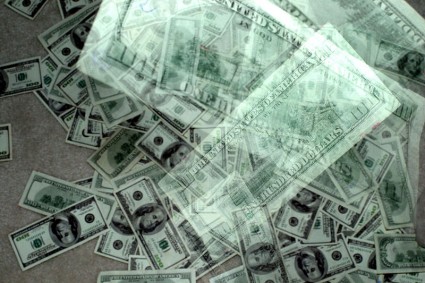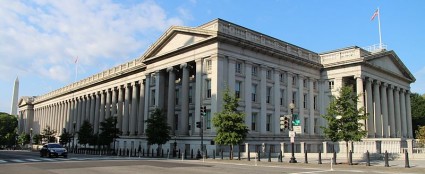Just over four years ago, we highlighted a recently declassified top secret 1968 telegram to the Secretary of State from the American Embassy in Paris, in which the big picture thinking behind the creation of the IMF's Special Drawing Right (rolled out shortly thereafter in 1969), or SDRs, was laid out. In that memo it was revealed that despite what some may think, the fundamental driver behind the promotion of a supranational reserve paper currency had one goal in mind: allowing the US to "remain masters of gold."
Specifically, this is among the top secret paragraphs said on a cold night in March 1968:
If we want to have a chance to remain the masters of gold an international agreement on the rules of the game as outlined above seems to be a matter of urgency. We would fool ourselves in thinking that we have time enough to wait and see how the S.D.R.'s will develop. In fact, the challenge really seems to be to achieve by international agreement within a very short period of time what otherwise could only have been the outcome of a gradual development of many years.
This then puts into question just what the true purpose of the IMF is. Because while its stated role of preserving the stability in developing, and increasingly more so, developed, countries is a noble one, what appears to have been the real motive behind the monetary fund's creation, was to promote and encourage the development of a substitute reserve currency, the SDR, and to ultimately use it as the de facto buffer and intermediary, for conversion of all the outstanding "barbarous relic" hard currency, namely gold, into the fiat of the future: the soon to be newly created SDR. All the while, and increasingly more so as more countries converted their gold into SDR, such remaining hard currency would be almost exclusively under the control of the United States.
Well, in the intervening 44 years, the SDR never managed to take off, the reason being that the dollar's reserve currency status was exponentially cemented courtesy of both the great moderation of the 1980s and the derivative explosion of the 1990s and post Glass Steagall repeal 2000s, when the world was literally flooded with roughly $1 quadrillion in USD-denominated derivatives, inextricably tying the fate of the world to that of the dollar.
However, back in 1974, shortly after Nixon ended the Bretton Woods system, and cemented the dollar's fate as a fiat currency, no longer convertible into gold, the future of the SDR was still bright, especially at a time when the US seemed set to suffer a very unpleasant date with inflationary reality following the 1973 oil crisis, leading to a potential loss of faith in the US dollar.
Which brings us to the topic of today's article: the international monetary system, reserve currency status, SDRs, and, of course, gold... again.
Below is a memo written in 1974 by Sidney Weintraub, Deputy Assistant Secretary of State for International Finance and Development, to Paul Volcker, when he was still just Under Secretary of the Treasury for Monetary Affairs and not yet head of the Federal Reserve. The source of the memo was found in the National Archives, RG 56, Office of the Under Secretary of the Treasury, Files of Under Secretary Volcker, 1969–1974, Accession 56–79–15, Box 1, Gold—8/15/71–2/9/72. No classification marking. A stamped notation on the note reads: "Noted by Mr. Volcker." Another notation, dated March 8, indicates that copies were sent to Bennett and Cross. It currently resides in declassified form in Document 61, Foreign Relations Of The United States, 1973–1976, Volume XXXI Foreign Economic Policy, and is found at the Office of the Historian website.
The memo is a continuation of the US thinking on the issue of the then brand new SDR, the fate of paper currencies, and the preservation of US control over reserve currency status. Most importantly, it addresses several approaches to dominating gold as well as the US' interest of banning gold from monetary system and capping the free market price, contrasted by the opposing demands of various European deficit countries (sound familiar?) on what the fate of gold should be at a time when the common European currency did not exist, and some European countries were willing to fund their deficits with gold: something the US naturally was not happy about.
While we urge readers to read the full memo on their own, here the two punchlines.
First, here is what the S intentions vis-a-vis gold truly are when stripped away of all rhetoric:
U.S. objectives for world monetary system—a durable, stable system, with the SDR [ZH: or USD] as a strong reserve asset at its center — are incompatible with a continued important role for gold as a reserve asset.... It is the U.S. concern that any substantial increase now in the price at which official gold transactions are made would strengthen the position of gold in the system, and cripple the SDR [ZH: or USD].
In other words: gold can not be allowed to dominated a "durable, stable system", and a rising gold price would cripple the reserve currency du jour: well known by most, but always better to see it admitted in official Top Secret correspondence.
We continue:
To encourage and facilitate the eventual demonetization of gold, our position is to keep the present gold price, maintain the present Bretton Woods agreement ban against official gold purchases at above the official price and encourage the gradual disposition of monetary gold through sales in the private market. An alternative route to demonetization could involve a substitution of SDRs for gold with the IMF, with the latter selling the gold gradually on the private market, and allocating the profits on such sales either to the original gold holders, or by other agreement.... Any redefinition of the role of gold must be based on the principle stated above: that SDR must become the center of the system and that there can be no question of introducing a new form of gold– paper and gold–metal bimetallism, in which the SDR and gold would be in competition.
And there, in three sentences, you have all the deep thinking behind the IMF's SDR: simply to use it as a vehicle through which a select few can accumulate gold (namely those who can create fiat SDRs d novo), while handing out paper "profits" to the happy sellers.
And just in case it was not quite clear, here it is again, point blank:
Option 3: Complete short-term demonetization of gold through an IMF substitution facility. Countries could give up their gold holdings to the IMF in exchange for SDRs. The gold could then be sold gradually, over time, by the IMF to the private market. Profits from the gold sales could be distributed in part to the original holders of the gold, allowing them to realize at least part of the capital gains, while part of the profits could be utilized for other purposes, such as aid to LDCs. Advantages: This would achieve our goal of demonetization and relieve the problem of gold immobility, since the SDRs received in exchange could be used for settlement with no fear of foregoing capital gains.Disadvantages: This might be a more rapid demonetization than several countries would accept. There would be no benefit from the viewpoint of financing oil imports with gold sales to Arabs (although it is not necessarily incompatible with such an arrangement).
One wonders just who in the "private market" would be stupid enough to convert their invaluable paper money into worthless, barbaric relics?
And finally, was there the tiniest hint of a proposed alternative system to the PetroDollar. Namely, PetroGold?
There is a belief among certain Europeans that a higher price of gold for settlement purposes would facilitate financing of oil imports... Although mobilization of gold for intra-EC settlement would help in the financing of imbalances among EC countries, it would not, of itself,provide resources for the financing of the anticipated deficit with the oil producers. For this purpose, it would be useful if the oil producers would invest some of their excess revenues in gold purchases from deficit EC countries at close to a market price. This would be an attractive proposal for European countries, and for the U.S., in that it would not involve future interest burdens and would avoid immediate problems arising from increased Arab ownership of European and American industry. (The Arabs could both sell the gold and use the proceeds for direct investment, so that the industry ownership problem would not be completely solved.) From the Arab point of view such an asset would have the advantages of being protected from exchange-rate changes and inflation, and subject to absolute national control.
One wonders if the price of gold is "high enough" now for Arab purposes, and just where the Arabs are now in their thinking of converting oil into gold... or alternatively into a gold-backed renminbi. And if not now, soon, once the pent up inflation in the Fed's $4 trillion, and rising, balance sheet inevitably start to leak out?

